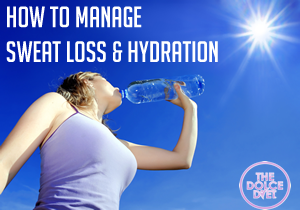DOLCE LIFESTYLE:
How to Manage Sweat Loss & Hydration
By Sydney Spoon, B.S. Nutrition and Dietetics, Dolce Diet Intern
Sweat rate during exercise is individual and influenced by age, genetics, gender, environment, exercise intensity, fitness, and acclimation. The process of evaporation of sweat during exercise cools the body. When an individual is dehydrated, it inhibits the body’s ability to cool itself during exercise. By consuming fluid, we replace the sweat that is lost along with the aid for cooling. The best way to gauge your hydration status is by monitoring urine color and volume. Ideally, urine should be a clear to a light yellow color. Dark urine and low in volume represents dehydration. Sodium retains fluid in the body and stimulates thirst.
Goals of Hydration
• Delay fatigue and maintain mental acuity
• Optimize the ability to regulate body heat, especially in hot environments
• Satisfy thirst and prevent significant weight loss from sweating
• Improve ability to recover quickly from training and competition.
• Stay well hydrated by drinking fluid during the day and within the hour before an exercise session.
• Rehydrate after exercise to replace weight lost as fluid during exercise.
• Prevent dehydration in forms of early fatigue, cardiovascular stress, increased risk of heat illness, and decreased performance.
Manage Your Sweat Loss
• Avoid losing more than 2% of your body weight during exercise. Weigh yourself before and after exercise (if you lost weight, you did not hydrate enough).
• Consistently provide fluids to your body as you continue to sweat.
• If your sweat is salty and contains a high concentration of sodium, replenish the sodium lost. Consume sodium such as endurance-specific sports drinks during exercise or eat salty foods before and after prolonged (>2 hours) of exercise.
What Should I Drink?
• Short duration exercise lasting 60 minutes a sports drink with 6-8% carbohydrate is a good option to replace both carbohydrates and electrolytes.
• Individuals who experience high sodium losses during exercise should eat salty foods pre-exercise or add salt to sports drinks consumed during exercise.
• Replacing fluid and sodium can be achieved through eating watery foods containing salt such as our Easy Lentil Soup. Replacing fluid and potassium can be done through consuming fruits and vegetables. A good example of both is eating watermelon with salt sprinkled on top like our Minty Watermelon Salad…YUM!





